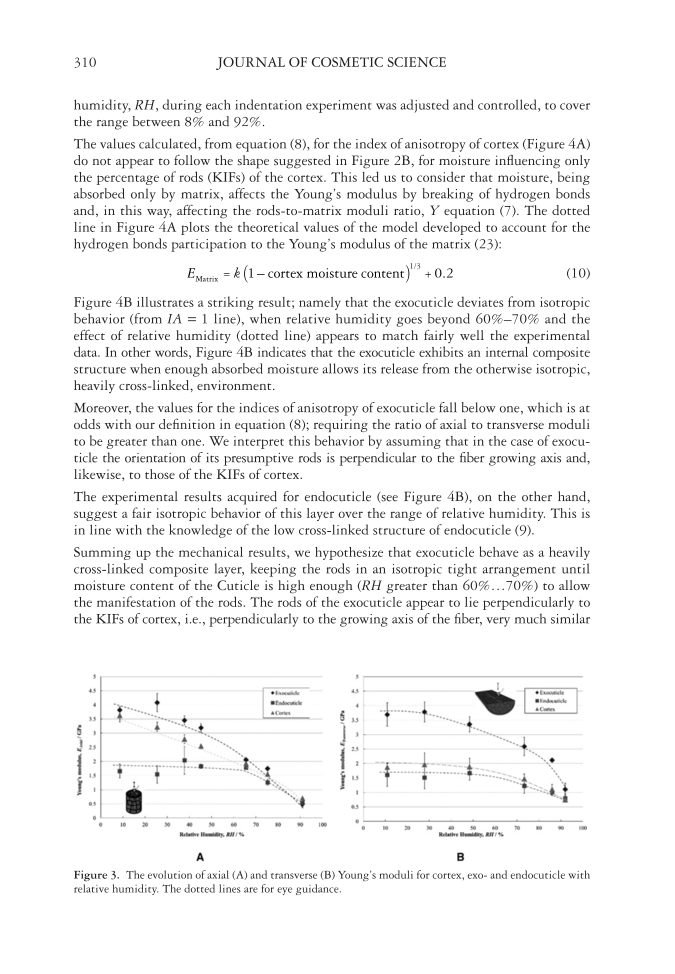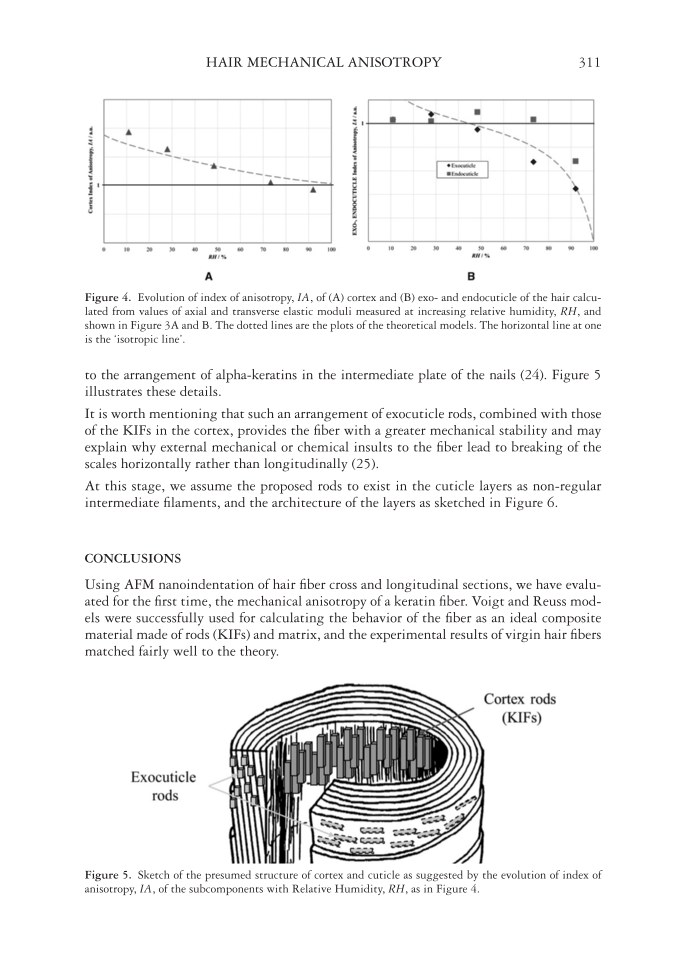JOURNAL OF COSMETIC SCIENCE 310 humidity, RH, during each indentation experiment was adjusted and controlled, to cover the range between 8% and 92%. The values calculated, from equation (8), for the index of anisotropy of cortex (Figure 4A) do not appear to follow the shape suggested in Figure 2B, for moisture infl uencing only the percentage of rods (KIFs) of the cortex. This led us to consider that moisture, being absorbed only by matrix, affects the Young’s modulus by breaking of hydrogen bonds and, in this way, affecting the rods-to-matrix moduli ratio, Y equation (7). The dotted line in Figure 4A plots the theoretical values of the model developed to account for the hydrogen bonds participation to the Young’s modulus of the matrix (23): 1/3 Matrix = 1– cortex moisture content +0.2 E k (10) Figure 4B illustrates a striking result namely that the exocuticle deviates from isotropic behavior (from IA = 1 line), when relative humidity goes beyond 60%–70% and the effect of relative humidity (dotted line) appears to match fairly well the experimental data. In other words, Figure 4B indicates that the exocuticle exhibits an internal composite structure when enough absorbed moisture allows its release from the otherwise isotropic, heavily cross-linked, environment. Moreover, the values for the indices of anisotropy of exocuticle fall below one, which is at odds with our defi nition in equation (8) requiring the ratio of axial to transverse moduli to be greater than one. We interpret this behavior by assuming that in the case of exocu- ticle the orientation of its presumptive rods is perpendicular to the fi ber growing axis and, likewise, to those of the KIFs of cortex. The experimental results acquired for endocuticle (see Figure 4B), on the other hand, suggest a fair isotropic behavior of this layer over the range of relative humidity. This is in line with the knowledge of the low cross-linked structure of endocuticle (9). Summing up the mechanical results, we hypothesize that exocuticle behave as a heavily cross-linked composite layer, keeping the rods in an isotropic tight arrangement until moisture content of the Cuticle is high enough (RH greater than 60%…70%) to allow the manifestation of the rods. The rods of the exocuticle appear to lie perpendicularly to the KIFs of cortex, i.e., perpendicularly to the growing axis of the fi ber, very much similar Figure 3. The evolution of axial (A) and trans verse (B) Young’s moduli for cortex, exo- and endocuticle with relative humidity. The dotted lines are for eye guidance.
HAIR MECHANICAL ANISOTROPY 311 to the arrangement of alpha-keratins in the intermediate plate of the nails (24). Figure 5 illustrates these details. It is worth mentioning that such an arrangement of exocuticle rods, combined with those of the KIFs in the cortex, provides the fi ber with a greater mechanical stability and may explain why external mechanical or chemical insults to the fi ber lead to breaking of the scales horizontally rather than longitudinally (25). At this stage, we assume the proposed rods to exist in the cuticle layers as non-regular intermediate fi laments, and the architecture of the layers as sketched in Figure 6. CONCLUSIONS Using AFM nanoindentation of hair fi ber cross and longitudinal sections, we have evalu- ated for the fi rst time, the mechanical anisotropy of a keratin fi ber. Voigt and Reuss mod- els were successfully used for calculating the behavior of the fi ber as an ideal composite material made of rods (KIFs) and matrix, and the experimental results of virgin hair fi bers matched fairly well to the theory. Figure 4. Evolution of index of anisotropy, IA, of (A) cortex and (B) exo- and endocuticle of the hair calcu- lated from values of axial and transverse elastic moduli measured at increasing relative humidity, RH, and shown in Figure 3A and B. The dotted lines are the plots of the theoretical models. The horizontal line at one is the ‘isotropic line’. Figure 5. Sketch of the presumed structure of corte x and cuticle as suggested by the evolution of index of anisotropy, IA, of the subcomponents with Relative Humidity, RH, as in Figure 4.
Purchased for the exclusive use of nofirst nolast (unknown) From: SCC Media Library & Resource Center (library.scconline.org)









































































































